|
|
|
Air/Fuel Mixture Control One of the greatest short coming for ultra light engines is the inability to adjust air fuel mixture during flight. As a result, the pilot is unable to provide timely engine management for unforeseen atmospheric changes which can cause excessive or lean fuel burn rates where the former wastes fuel and the latter can cause a scuffed piston and cylinder. This may not be a problem if one is just flying around the patch. But if you are trying to cross country using a five gallon tank, uncertainty about fuel flow prevents one from taking advantage of longer distance and time saving flights before refueling. Also, with an in the cockpit adjustable air fuel mixture control, there are no take-off surprises and one can set the desired EGT to maintain hight engine efficiency and to minimize flight fuel costs. All carburetors are ground adjustable, and so the approach taken has been to fool the Bing carburetor into acting like the float level is being mechanically changed. One starts by ground setting the carburetor needle for the coldest, driest, and lowest altitude air density expected. For the fixed float level this means the engine will run rich for all other conditions with the float bowl vents vented normally. To simulate lowering the float level, the air pressure in the float bowl is lowered until the desired EGT is reached. Lowering the pressure over the float bowl increases the pressure difference required to draw the same amount of fuel up past the needle and jet into the carburetor throat for a given throttle setting. This approach was selected so that if any part of the system fails, the engine will continue to run rich and prevent engine damage. |
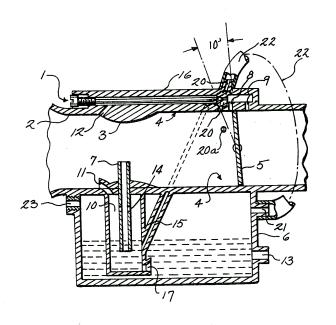 The trick is to find a steady reliable vacuum source. I have tried many things and discarded them as being too complicated or heavy. Two events made this latest attempt possible. First, Richard Pike, a member of the Kolb email list, sent me a little probe device that was used to ground richen the mixture with out needle adjustment. This probe made it apparent that one could derive enough vacuum through a probe to lift fuel from the float bowl up to the top of the carburetor inlet.
And second, while web surfing, I found a US Patent, #4040399, that explains how to use vacuum over the float bowl to lean out the air fuel mixture.
The trick is to find a steady reliable vacuum source. I have tried many things and discarded them as being too complicated or heavy. Two events made this latest attempt possible. First, Richard Pike, a member of the Kolb email list, sent me a little probe device that was used to ground richen the mixture with out needle adjustment. This probe made it apparent that one could derive enough vacuum through a probe to lift fuel from the float bowl up to the top of the carburetor inlet.
And second, while web surfing, I found a US Patent, #4040399, that explains how to use vacuum over the float bowl to lean out the air fuel mixture.
|
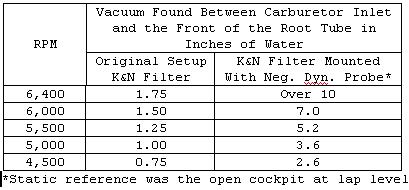 To find out how much vacuum could be generated, I drilled a hole in the Bing carburetor inlet so that I could measure the static pressure drop across the filter. Using the same hole, I slipped a second 1/8 inch OD tube inside the first. This probe was closed on the inner carburetor inlet end and drilled with a 1/16 inch drill bit so that dynamic pressures could be measured. With the 1/16 inch diameter hole turned down stream and connected to a zero to ten inches scale water manometer, it was easy to peg the manometer at less than full throttle. This indicated that an inlet probe would be a suitable vacuum source.
To find out how much vacuum could be generated, I drilled a hole in the Bing carburetor inlet so that I could measure the static pressure drop across the filter. Using the same hole, I slipped a second 1/8 inch OD tube inside the first. This probe was closed on the inner carburetor inlet end and drilled with a 1/16 inch drill bit so that dynamic pressures could be measured. With the 1/16 inch diameter hole turned down stream and connected to a zero to ten inches scale water manometer, it was easy to peg the manometer at less than full throttle. This indicated that an inlet probe would be a suitable vacuum source.
|
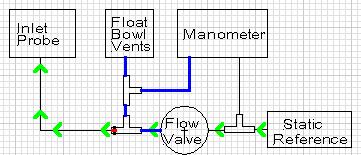 The way the system works is shown in the block diagram. Air flows (green arrows) from the reference source through the flow or throttling valve and passes through a critical orifice (red) and on to and exits through the inlet probe. There is little to no flow in the controlled pressure line (blue) due to the fact that the air volumes above the liquid in the float bowl, the low pressure side of the manometer, and connecting tubing is small and constant.
The way the system works is shown in the block diagram. Air flows (green arrows) from the reference source through the flow or throttling valve and passes through a critical orifice (red) and on to and exits through the inlet probe. There is little to no flow in the controlled pressure line (blue) due to the fact that the air volumes above the liquid in the float bowl, the low pressure side of the manometer, and connecting tubing is small and constant.
The critical orifice (red) is a flow limiting device whose characteristic is to pass the same flow rate for all pressure differences above a certain point. Its ID is 1/32 of an inch which is four times smaller than the hole in the probe. The idea is to be able to control pressure with very little air flow. This keeps down component weight, and does not require re-jetting the carburetor. The flow control valve is a needle valve. By adjusting this valve one can control the pressure seen by the float bowl vents and the manometer from zero to minus five inches or so of water. Closing the valve decreases the pressure over the flow bowl, leaning the mixture and increasing the EGT. As the final pressure determination is made by use of the EGT indicator, the manometer is unnecessary. I added the manometer because I like to know and put a number on what is going on. The manometer is referenced to the static air pressure just below the carburetor bowl. It weighs 4.4 ounces complete with mounting hardware. |
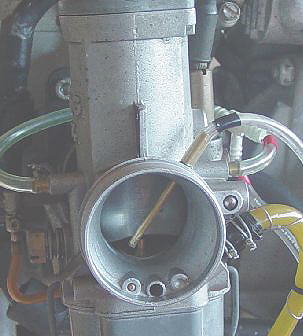 The inlet probe is offset so that it does not disturb the air directly in front of the needle, but it is low enough so that it receives good air flow at the lower engine rpm. Also, one can see that the carburetor air vents are "Teed" together.
The inlet probe is offset so that it does not disturb the air directly in front of the needle, but it is low enough so that it receives good air flow at the lower engine rpm. Also, one can see that the carburetor air vents are "Teed" together.
The tubing was color coded. Red signifies controlled pressure and black indicates vacuum source. Not shown is the static air pressure tap on the bottom of the carburetor. These three tubes run together from the engine up to the left lower side of the cockpit. I did try to use the altitude compensation tap that leads to the underneath side of the carburetor slide. It is a good vacuum source and it worked well, but it tends to lean out the idle mixture setting and lowered idle rpm. The probe does not influence idle rpm. |
 The valve was modified as shown to the left. The bottom of the valve terminated in a male 10-32 thread. A small length of aluminum tubing was used as a collar, and JB Weld was used to hold the collar to the valve and the hose nipple to the collar. This valve was selected because the needle has an upper limit stop so that the needle cannot be removed from the valve body.
The valve was modified as shown to the left. The bottom of the valve terminated in a male 10-32 thread. A small length of aluminum tubing was used as a collar, and JB Weld was used to hold the collar to the valve and the hose nipple to the collar. This valve was selected because the needle has an upper limit stop so that the needle cannot be removed from the valve body.
|
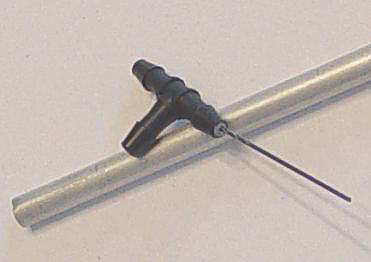 The vacuum flow orifice was formed by plugging the end of a 1/8 inch "Tee" with JB Weld, and then drilling a 1/32 inch OD hole through the JB Weld. This size was a first guess. Since I have not experienced any adverse effects, I have not experimented with different holes sizes. A smaller hole may work as well.
The vacuum flow orifice was formed by plugging the end of a 1/8 inch "Tee" with JB Weld, and then drilling a 1/32 inch OD hole through the JB Weld. This size was a first guess. Since I have not experienced any adverse effects, I have not experimented with different holes sizes. A smaller hole may work as well.
|
 Since there is no room left on the panel for another gage, a mount was fabricated to attach the gage to the upper left windshield support bow. This is a Ashcroft Low Pressure 2 1/2" Diaphragm Gauge that was purchased from smallparts.com.
Since there is no room left on the panel for another gage, a mount was fabricated to attach the gage to the upper left windshield support bow. This is a Ashcroft Low Pressure 2 1/2" Diaphragm Gauge that was purchased from smallparts.com.
The mount was made from 1/4 inch thick plywood where the dial side piece is attached to the meter and the second piece just slides over the meter and clamps to the bow and the meter. To form a good clamping surface to the 5/16 inch OD bow tube, a piece of 5/16 inch OD Tygon tubing was used as a mold and glued to the mating surface on the plywood. After the JB Weld had hardened, one could peel the Tygon away from the JB Weld. |
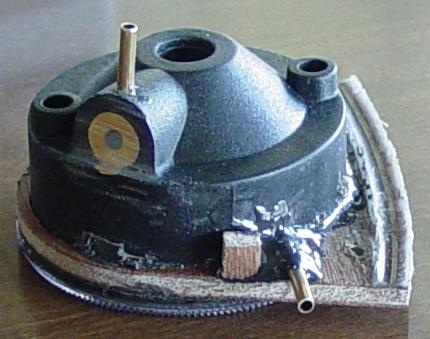 The vacuum gage was modified to convert it to a manometer and to remove weight. The brass threaded end was removed. A 1/8th inch OD hole was drilled from the back to accept a brass tube that would be used as a hose nipple. After this hole was drilled and all shavings were shaken out through the original port, the original port was plugged with JB Weld. For the gage to work properly as a vacuum gage, the case has to breath, and so by design there is a port on the bottom front of the case behind the screw on bezel. To convert to a manometer a hole was drilled into the case to accept a second tube hose nipple and the front bezel sealed to the case with JB Weld.
The vacuum gage was modified to convert it to a manometer and to remove weight. The brass threaded end was removed. A 1/8th inch OD hole was drilled from the back to accept a brass tube that would be used as a hose nipple. After this hole was drilled and all shavings were shaken out through the original port, the original port was plugged with JB Weld. For the gage to work properly as a vacuum gage, the case has to breath, and so by design there is a port on the bottom front of the case behind the screw on bezel. To convert to a manometer a hole was drilled into the case to accept a second tube hose nipple and the front bezel sealed to the case with JB Weld.
|
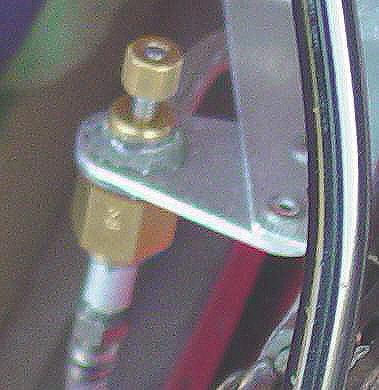 The valve was mounted in a bracket with JB Weld and attached to control cluster next to the choker and throttle. The knob is too small to be adjusted with gloved hands, and so I will increase the knob diameter. Currently, I believe a soda bottle cap would be a good candidate for the job.
The valve was mounted in a bracket with JB Weld and attached to control cluster next to the choker and throttle. The knob is too small to be adjusted with gloved hands, and so I will increase the knob diameter. Currently, I believe a soda bottle cap would be a good candidate for the job.
|
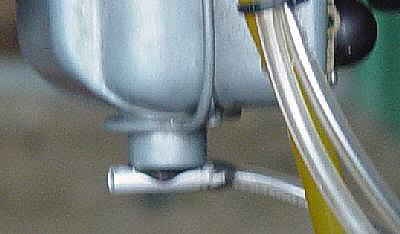 The system static air reference point is located below the carburetor float bowl in about the same location as the original float bowl venting tube. This ensures that the manometer reads the true pressure reduction over the fuel in the float bowl.
The system static air reference point is located below the carburetor float bowl in about the same location as the original float bowl venting tube. This ensures that the manometer reads the true pressure reduction over the fuel in the float bowl.
If one chose to not use a manometer, this line to the carburetor could be excluded and one would save about five ounces. |
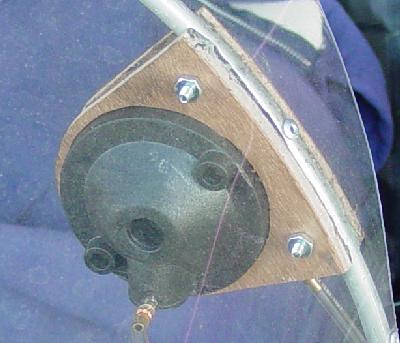 Looking through the windshield, one can see the gage mounting.
Looking through the windshield, one can see the gage mounting.
The rear mounting ring, facing toward the camera, is not attached to the gage. It slides into place. To keep this ring from moving forward as the clamping screws are tightened, pivot blocks were glued to the front mounting ring to take up the load and maintain parallelism between the two rings. One of these blocks can be seen in a previous photo showing the back side of the gage. |
|
I believe this system will work with any Bing carburetor. To adapt it to two carburetor systems, only one probe needs to be installed. To control both carburetors, one would joint all vents together to one pressure control line. Due to the increased non-flow volume, control response may be a little slower than for a single carburetor system. Cost of system components is very modest. The Clippard valve including the hose nipples was less than ten dollars. The vacuum gage cost less than $40.
System operation is as follows:
If raising the EGT requires less than one inch of H20, it would be best to raise the Bing needle at least another quarter of a slot. Also, if after cruising at the desired EGT and the valve is completely opened and the EGT does not want to fall, one must raise the Bing needle to make sure the needle valve can drive the mixture rich.
If the valve is completely closed and the EGT does not reach the desired EGT, it indicates that the Bing needle needs to be lowered to help lean out the mixture.
|
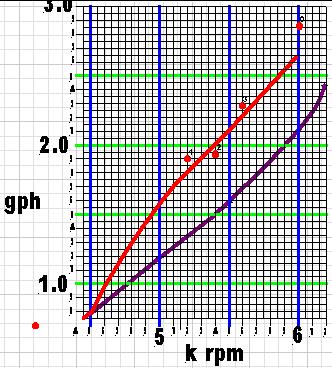 Slowly I am recording data from test flights. The tank is topped off and read before each flight so that beginning wing loading is a constant. The engine is started and after the coolant reaches 130 degrees F and two minutes have passed, takeoff is initiated and the flight timer is started. Climb out for the first two minutes is at 6,200 rpm and then the throttle is retarded to the test cruise rpm. The engine is leaned to the desired EGT, and a cruise climb continued to 2,500 feet asl. The test flight is flown in a large loop so that if necessary it can be truncated so that the flight time is over 30 but less than 35 minutes. Constant rpm decent is made from 2,500 feet and around the pattern. Upon touch down the flight timer is turned off. The FireFly is taxied back to the hangar and the engine shut down. Then the craft is pulled into the hangar so that it sits in the same exact position and the tank fuel level read.
Slowly I am recording data from test flights. The tank is topped off and read before each flight so that beginning wing loading is a constant. The engine is started and after the coolant reaches 130 degrees F and two minutes have passed, takeoff is initiated and the flight timer is started. Climb out for the first two minutes is at 6,200 rpm and then the throttle is retarded to the test cruise rpm. The engine is leaned to the desired EGT, and a cruise climb continued to 2,500 feet asl. The test flight is flown in a large loop so that if necessary it can be truncated so that the flight time is over 30 but less than 35 minutes. Constant rpm decent is made from 2,500 feet and around the pattern. Upon touch down the flight timer is turned off. The FireFly is taxied back to the hangar and the engine shut down. Then the craft is pulled into the hangar so that it sits in the same exact position and the tank fuel level read.
The gph rates are computed using the gallons of fuel used divided by the air time in minutes and this number multiplied by 60 minutes. I consider these values to be conservative, in that, if one flew one to two hours, it would greatly reduce the significance of takeoff and before leaning out burn rates and warm up and taxi fuel. As I acquire additional data, I will up date the chart. |
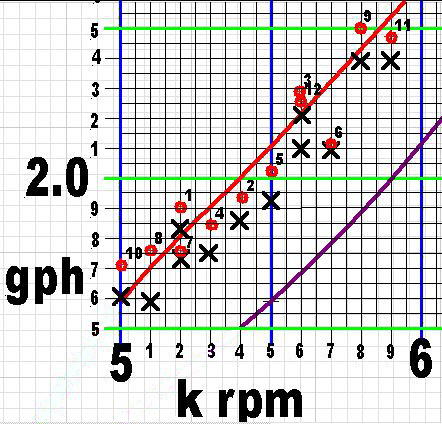 Here are the latest data. The red dots represent the data calculated as described above. The "X" is an adjusted fuel flow rate to compensate for the fuel used during engine start and warm up, and taxi in and out. This volume of 0.05 gallons was found by using the method described above but no flight took place. And so 0.05 gallons was subtracted from the total amount of fuel used and before the air time fuel flow was calculated.
Here are the latest data. The red dots represent the data calculated as described above. The "X" is an adjusted fuel flow rate to compensate for the fuel used during engine start and warm up, and taxi in and out. This volume of 0.05 gallons was found by using the method described above but no flight took place. And so 0.05 gallons was subtracted from the total amount of fuel used and before the air time fuel flow was calculated.
This shows that this is a significant amount of fuel. If one notes the vertical distance between the two points for a given rpm, there is a variation in relation to the total amount of air time. #8 was 16 minutes, and #7&6 were one hour, 15 minutes plus, and all the other flights were 30 to 33 minutes long. This is a more accurate method that what I have previously used, but still, it does not take into account a full throttle climb out, cruise climb and descent. A better method would be to measure the consumption time of a given amount of fuel while in level flight at constant rpm. During the data time taking period, it was discovered that my choice for the static air pressure reference point was not a good one. To maintain greater pressure differences, the static pressure reference point was moved under the wing to the root tube on top of the main spar cage pass through. This high pressure region ensures there is sufficient needle valve adjustment to allow low EGT power for take off and initial climb.
At this point, I am very pleased with the result. The adjustment system is very stable and gives predictable fuel flow rates independent of atmospheric conditions. With the needle raised 1/2 slot above the normal winter position, the system can raise the EGT at least 150 degrees F. On the last test flight it required 3.0 inches of water vacuum to bring the EGT up to the desired temperature.
To check air fuel ratio control system effectiveness, I totaled the air time and fuel used beginning with the very first system test flight. The total system air time was 13 hours and 23 minutes, and the total fuel burned was 27.17 gallons. This computes out to 2.03 gph over 25 flights. Next I went back in air time approximately 13 hours and 23 minutes before installing the system and found there were 35 flights in this period totaling 13 hours, 46 minutes that burned 33.20 gallons. Since there were 10 additional flights, 10 x 0.05 = 0.5 gallons was subtracted from the total to compensate for the extra ten engine starts and warm-ups etc. Using this new number (32.70 gallons) the uncontrolled air fuel mixture flights burn rate was 2.38 gph. By addition of the air fuel mixture control, Victor 1+ is burning 0.35 gph less for an fifteen percent improvement in fuel economy.
Taking data from my flight log, I totaled the fuel for the last 13 hours 29 minutes of flight before removing the Rotax 447. During this time the Rotax burned 57.8 gallons in 13.48 hours over 42 flights. Subtracting 0.05 gal per flight for warm up and taxi gives an air time fuel burn of 55.7 gallons or an overall fuel burn rate of 4.19 gph. This indicates that by mounting the Victor 1+ and adding an air fuel mixture control, every second hour flown with the Victor 1+ is free when compared to the Rotax 447. |
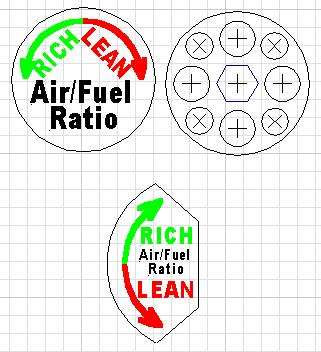 Made a valve control knob from thick brass shim stock. Drilled lightening holes. The middle hex hole fits the hex on the original valve. Also shown are the labels. The manometer label was covered with packaging tape and trimmed so there was about 1/16th of an inch border of over lapping the label. This uncovered sticky side was used to hold the label to the manometer bezel. The valve label was covered with packaging tape on both sides and trimmed to be slightly larger than the label. Then JB Weld was used to fix the back side to the knob. After the glue hardened, a second daub was placed in the hex hole and the knob installed on the valve control screw.
Made a valve control knob from thick brass shim stock. Drilled lightening holes. The middle hex hole fits the hex on the original valve. Also shown are the labels. The manometer label was covered with packaging tape and trimmed so there was about 1/16th of an inch border of over lapping the label. This uncovered sticky side was used to hold the label to the manometer bezel. The valve label was covered with packaging tape on both sides and trimmed to be slightly larger than the label. Then JB Weld was used to fix the back side to the knob. After the glue hardened, a second daub was placed in the hex hole and the knob installed on the valve control screw.
|
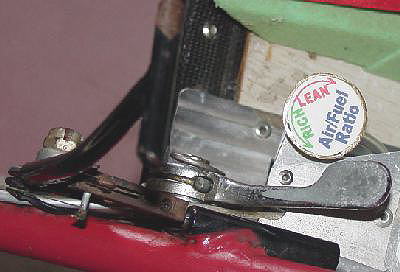 This is looking down from above the throttle and choker while standing by the left side of the cockpit.
This is looking down from above the throttle and choker while standing by the left side of the cockpit.
The knob is well below the choker in it's off position, so there is no interference with revolving the knob with the fingers of the left hand. |
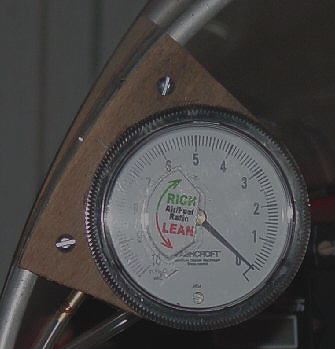 Standing on the same side of the cockpit, this is the manometer.
Standing on the same side of the cockpit, this is the manometer.
|
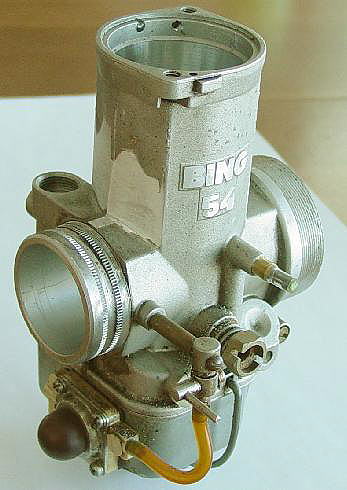 The back carburetor float bowl vent was plugged. With the use of the air mixture control, there is no need for two vents. Removing the connecting tubing and "Tee" fitting saved 0.2 ounces of weight.
The back carburetor float bowl vent was plugged. With the use of the air mixture control, there is no need for two vents. Removing the connecting tubing and "Tee" fitting saved 0.2 ounces of weight.
While the carburetor was removed from the engine, the original choker mechanism boss was removed. This saved another 0.2 ounces. |
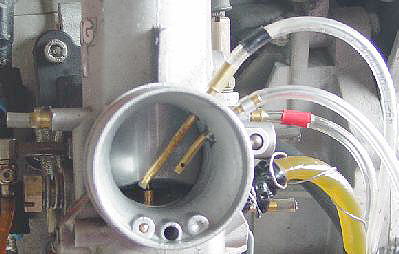 After thinking about trying to recover some pressure loss due to carburetor placement and the air filter media, I settled on adding a positive dynamic pressure tap to the carburetor inlet. The advantage of doing this is that the pressure differentials come from a common source, and should be evenly affected by changes in carburetor inlet pressures.
After thinking about trying to recover some pressure loss due to carburetor placement and the air filter media, I settled on adding a positive dynamic pressure tap to the carburetor inlet. The advantage of doing this is that the pressure differentials come from a common source, and should be evenly affected by changes in carburetor inlet pressures.
This has been verified by mounting the air filter scoop at various angles of attack, and seeing little influence on the air fuel mixture control system. I worried that if the mixture control was set to full rich, the positive dynamic probe pressure might become so high as to flood the carburetor, but this has not proven to be the case. The new probe is seen on the right. The photo was not taken from straight on, and it may not be apparent but, both probes straddle the needle so that they will not interfere with flow past the needle. The red band tube connects to the float bowl vent, the black band tube connects to the negative dynamic pressure probe, and the no band tube connects to the positive dynamic pressure probe. On the left one can see the plugged float bowl vent. System performance is very good. One can raise the EGT by more than 200 degrees F. After climb out one can dial in the desired EGT, and it will pretty much remain constant for the entire flight. So far I have found that as one reduces the throttle or if one unloads the propeller with out further system adjustment, the EGT will remain stable. At this point it seems almost too good to be true. Upon closing the throttle the mixture will go rich. To obtain take off full power, the control must be set to full rich. Fuel flow rates remain favorable. The new mixture control diagram follows: |
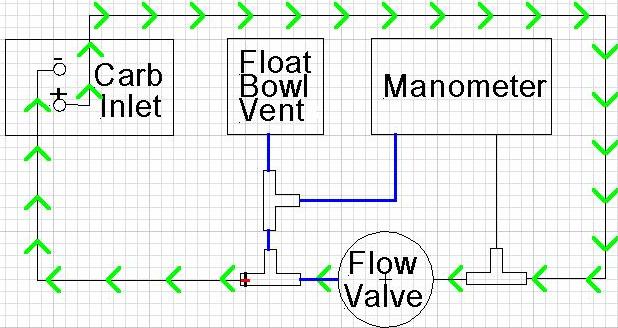
|